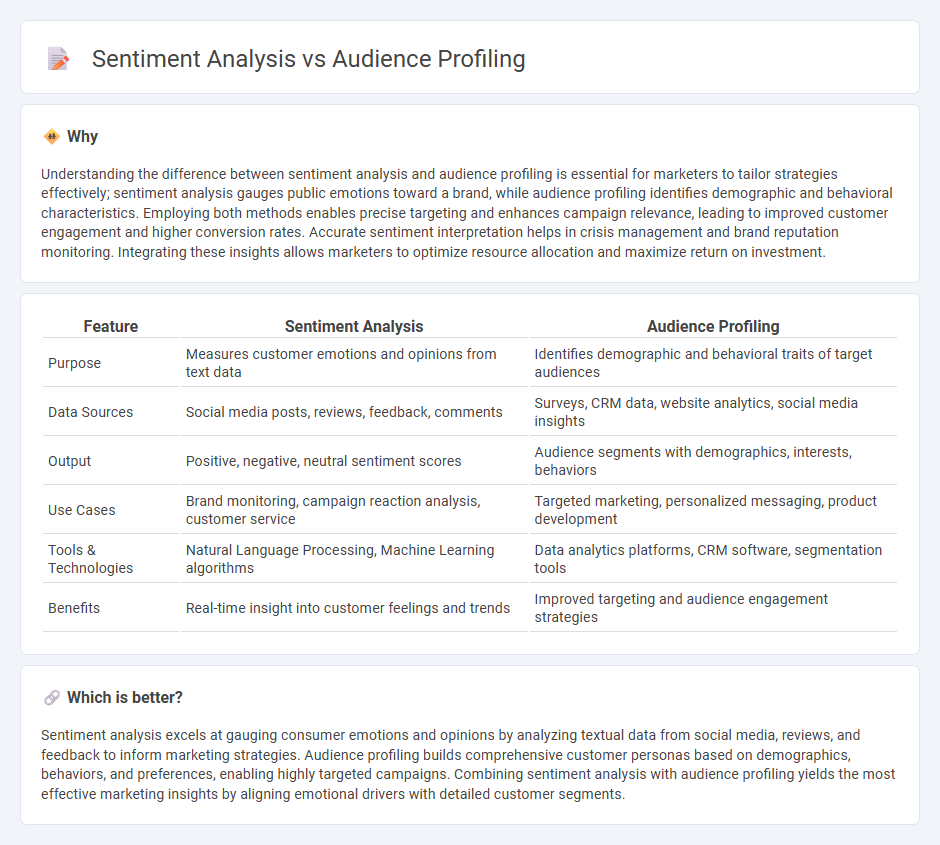
Sentiment analysis evaluates customer emotions by analyzing text data from reviews, social media, and surveys to gauge public perception and brand reputation. Audience profiling segments consumers based on demographics, behaviors, and preferences to tailor marketing strategies effectively. Explore how integrating sentiment analysis and audience profiling can enhance targeted marketing campaigns and boost customer engagement.
Why it is important
Understanding the difference between sentiment analysis and audience profiling is essential for marketers to tailor strategies effectively; sentiment analysis gauges public emotions toward a brand, while audience profiling identifies demographic and behavioral characteristics. Employing both methods enables precise targeting and enhances campaign relevance, leading to improved customer engagement and higher conversion rates. Accurate sentiment interpretation helps in crisis management and brand reputation monitoring. Integrating these insights allows marketers to optimize resource allocation and maximize return on investment.
Comparison Table
| Feature | Sentiment Analysis | Audience Profiling |
|---|---|---|
| Purpose | Measures customer emotions and opinions from text data | Identifies demographic and behavioral traits of target audiences |
| Data Sources | Social media posts, reviews, feedback, comments | Surveys, CRM data, website analytics, social media insights |
| Output | Positive, negative, neutral sentiment scores | Audience segments with demographics, interests, behaviors |
| Use Cases | Brand monitoring, campaign reaction analysis, customer service | Targeted marketing, personalized messaging, product development |
| Tools & Technologies | Natural Language Processing, Machine Learning algorithms | Data analytics platforms, CRM software, segmentation tools |
| Benefits | Real-time insight into customer feelings and trends | Improved targeting and audience engagement strategies |
Which is better?
Sentiment analysis excels at gauging consumer emotions and opinions by analyzing textual data from social media, reviews, and feedback to inform marketing strategies. Audience profiling builds comprehensive customer personas based on demographics, behaviors, and preferences, enabling highly targeted campaigns. Combining sentiment analysis with audience profiling yields the most effective marketing insights by aligning emotional drivers with detailed customer segments.
Connection
Sentiment analysis enhances audience profiling by identifying emotional tones in customer feedback, enabling marketers to categorize audiences based on their attitudes and preferences. This connection allows for more precise targeting and personalized marketing strategies that resonate with specific segments. Integrating sentiment data with demographic and behavioral profiles improves campaign effectiveness and customer engagement.
Key Terms
**Audience Profiling:**
Audience profiling involves collecting and analyzing demographic, psychographic, and behavioral data to create detailed customer segments, enabling targeted marketing strategies. This process uses tools such as CRM systems, surveys, and social media analytics to identify audience preferences and purchasing behaviors. Explore more about how audience profiling can enhance your marketing efforts and improve customer engagement.
Demographics
Audience profiling leverages demographic data such as age, gender, location, income, and education to segment and target specific groups effectively. Sentiment analysis, on the other hand, primarily interprets emotional responses and opinions from text data without directly considering demographic factors. Explore how combining both approaches can enhance marketing strategies and customer insights.
Psychographics
Audience profiling involves segmenting a market based on demographics, behaviors, and psychographics, which encompass interests, values, and lifestyle traits. Sentiment analysis focuses on determining the emotional tone behind textual data, such as social media posts or product reviews, to gauge public opinion and customer feelings. Explore how integrating psychographic insights with sentiment analysis can enhance targeted marketing strategies and customer engagement.
Source and External Links
What is Audience Profiling? Everything You Need To Know - GWI - Audience profiling involves analyzing and segmenting audiences based on shared behaviors and other factors such as lifestyles, attitudes, and interests to market effectively, following a four-stage process: segmentation, messaging, engagement, and measurement.
Segmentation: How to Perfect Audience Profiling and Targeting - GWI - Modern audience profiling goes beyond demographics to include behavioral data and perceptions, enabling brands to deliver personalized customer experiences at every touchpoint through detailed audience segmentation.
What Is Audience Profiling and Why Is It Important? - Compose.ly - Audience profiling is a targeted method using collected data and demographics to create personalized content strategies by grouping audiences into demographic, behavioral, needs-based, and psychographic segments for effective targeting.
 dowidth.com
dowidth.com